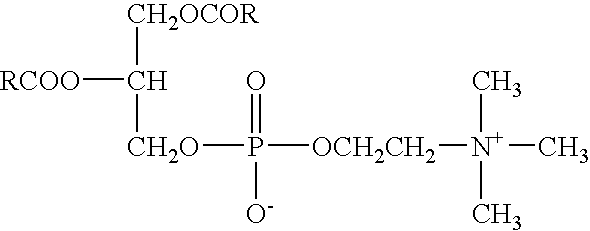Detergent mixture
a technology of detergent mixture and mixture, which is applied in the direction of detergent composition, detergent compounding agent, transportation and packaging, etc., can solve the problems of solvent removal, time-consuming and expensive processes, and difficult reaction of lipophilic fatty acid chloride with hydrophilic amino acid or basic salt in aqueous medium,
- Summary
- Abstract
- Description
- Claims
- Application Information
AI Technical Summary
Benefits of technology
Problems solved by technology
Method used
Image
Examples
example 1
Preparation of a Surfactant Mixture of C.sub.12-C.sub.18 acyl glutamate disodium salt and C.sub.12-C.sub.18 acyl protein condensate based on wheat protein hydrolyzate
[0109] 76 g water, 187 g (1 mol) monosodium glutamate (.times.1H.sub.2O), 103 g 37% sodium hydroxide and 30 g wheat protein hydrolyzate (56% by weight active substance, 0.8% by weight acylatable nitrogen) were introduced into a reactor and cooled to 10-20.degree. C. Before the start of the reaction, the pH was adjusted to ca. 12 with 11% sodium hydroxide. 208 g (0.95 mol) cocoyl fatty acid chloride and 308 g 11% NaOH were then simultaneously added at such a rate that the reactor temperature did not exceed 20-25.degree. C. and the pH stayed between 11.5 and 12.5. After addition of the fatty acid chloride, the reaction mixture was stirred and simultaneously circulated (via the circulation pipe with mixer and heat exchanger) in the reactor for about another 2 hours at 20-25.degree. C., followed by heating for about another...
example 2
Preparation of a Surfactant Mixture of C.sub.12-C.sub.18 Acyl Glutamate Disodium Salt and C.sub.12-C.sub.14 Alkyl Polyglucoside
[0110] 76 g water, 187 g (1 mol) monosodium glutamate (.times.1H.sub.2O), 103 g 37% sodium hydroxide and 56 g C.sub.12-C.sub.14 alkyl polyglucoside (50% AS) were introduced into a reactor and cooled to 10-20.degree. C. Before the start of the reaction, the pH was adjusted to ca. 12 with 11% sodium hydroxide. 177 g (0.8 mol) cocoyl fatty acid chloride and 296 g 11% NaOH were then simultaneously added at such a rate that the reactor temperature did not exceed 20-25.degree. C. and the pH stayed between 11.5 and 12.5. After addition of the fatty acid chloride, the reaction mixture was stirred and simultaneously circulated (via the circulation pipe with mixer and heat exchanger) in the reactor for about another 2 hours at 20-25.degree. C., followed by heating for about another 2 hours to 60-80.degree. C. The reaction mixture was then cooled to room temperature an...
example 3
Preparation of a Surfactant Mixture of C.sub.12-C.sub.18 Acyl Glutamate Disodium Salt and C.sub.12-C.sub.18 Acyl Tauride Sodium salt
[0111] 76 g water, 187 g (1 mol) monosodium glutamate (.times.1 H.sub.2O), 103 g 37% sodium hydroxide and 24.8 g N-methyltaurine Na (50% active substance in water) were introduced into a reactor and cooled to 10-20.degree. C. Before the start of the reaction, the pH was adjusted to ca. 12 with 11% sodium hydroxide. 211 g (0.96 mol) cocoyl fatty acid chloride and 352 g 11% NaOH were then simultaneously added at such a rate that the reactor temperature did not exceed 20-25.degree. C. and the pH stayed between 11.5 and 12.5. After addition of the fatty acid chloride, the reaction mixture was stirred and simultaneously circulated (via the circulation pipe with mixer and heat exchanger) in the reactor for about another 2 hours at 20-25.degree. C., followed by heating for about another 2 hours to 60-80.degree. C. The reaction mixture was then cooled to room t...
PUM
 Login to View More
Login to View More Abstract
Description
Claims
Application Information
 Login to View More
Login to View More - R&D
- Intellectual Property
- Life Sciences
- Materials
- Tech Scout
- Unparalleled Data Quality
- Higher Quality Content
- 60% Fewer Hallucinations
Browse by: Latest US Patents, China's latest patents, Technical Efficacy Thesaurus, Application Domain, Technology Topic, Popular Technical Reports.
© 2025 PatSnap. All rights reserved.Legal|Privacy policy|Modern Slavery Act Transparency Statement|Sitemap|About US| Contact US: help@patsnap.com


